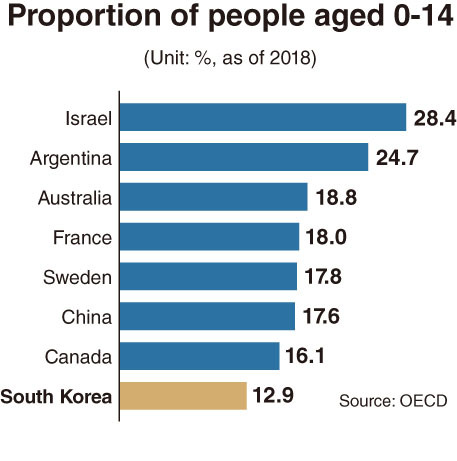[News Focus] Korea ranks 51st among 52 major countries in youth population
By Kim Yon-sePublished : April 12, 2020 - 17:21

SEJONG -- South Korea has seen the percentage of its youth population drastically decline over the past three decades, while youth accounted for 27.3 percent of the population in 1988.
According to a global comparison of 52 countries by the Organization for Economic Development and Cooperation, the nation’s youth population aged up 14 plunged to 12.9 percent as of 2018, after falling below the 20 percent mark in 2004 for the first time.
Among the 52 countries with major economies, involving 36 OECD members, Korea ranked No. 51 in the percentage of youth population in 2018. The figure of 12.9 percent far falls short of the average of the Group of 20 (21.3 percent), OECD (17.7 percent) and EU (15.5 percent).
South Africa topped the list, as its youth population marked 29.5 percent in 2018, trailed by Israel with 28.4 percent, India at 27.4 percent, Indonesia with 26.6 percent and Mexico, 26.5 percent.
The remaining in the top 10 were Colombia (25.9 percent), Argentina (24.7 percent), Saudi Arabia (24.6 percent), Turkey (23.5 percent) and Costa Rica (22.2 percent). These 10 included three OECD members: Israel, Mexico and Turkey.

Among English-speaking nations, New Zealand posted 19.3 percent, followed by Australia at 18.8 percent, the US at 18.6 percent, the UK at 17.9 percent and Canada, 16.1 percent.
Out of major European economies, France saw its figure come to 18 percent, Sweden with 17.8 percent, Norway at 17.6 percent, the Netherlands at 16 percent, Spain with 14.8 percent, Germany with 13.5 percent and Italy with 13.3 percent.
Among other Asian nations, China posted 17.6 percent, Singapore with 14.8 percent and Japan just 12.2 percent (the lowest of the 52 countries).
South Korea is projected to see lower figures than Japan in the coming years, given that the figures for Korea -- unveiled by the Ministry of Interior and Safety -- have been posting a steeper downhill gradient in recent years compared to the latter.
The Interior Ministry data shows the portion of young Koreans declined from 16.4 percent in March 2010 to 14 percent in March 2015 and 12.4 percent in March 2020.
Korea has become one of several countries undergoing rapid demographic changes that could dent the nation’s competitiveness in the mid to long term.
With fewer babies being born, senior citizens make up a growing proportion of the Korean population, and the average age has climbed over the past decade.
According to the ministry, the average age was 42.8 years old (41.6 for men and 43.9 for women) as of March 2020, as compared to 37.7 a decade earlier.
The average age exceeded 40 in 16 of the 17 major cities and provinces in Korea, with the city of Sejong being the sole exception, with an average age of 37. The capital Seoul recorded 42.8.
Korea’s birthrate fell to a fresh record low of 0.85 children per woman as of the fourth quarter of 2019. The number of marriages posted 65,769 during the October-December period, down 8 percent over the same period a year earlier.
The nation’s birthrate continued to decline in the 1990s and 2000s, posting 1.187 in 2013. The figure for 2018 was 0.977, below the 1 mark for the first time in history, and hit 0.88 as of September 2019, according to Statistics Korea.
“People in their 20s and 30s are avoiding marriage or childbirth in the wake of their frustration over a tough job market and skyrocketing apartment prices -- in Seoul particularly -- and the like,” said a demographic researcher in Sejong.
By Kim Yon-se (kys@heraldcorp.com)



![[Herald Interview] 'Amid aging population, Korea to invite more young professionals from overseas'](http://res.heraldm.com/phpwas/restmb_idxmake.php?idx=644&simg=/content/image/2024/04/24/20240424050844_0.jpg&u=20240424200058)






![[Hello India] Hyundai Motor vows to boost 'clean mobility' in India](http://res.heraldm.com/phpwas/restmb_idxmake.php?idx=644&simg=/content/image/2024/04/25/20240425050672_0.jpg&u=)







